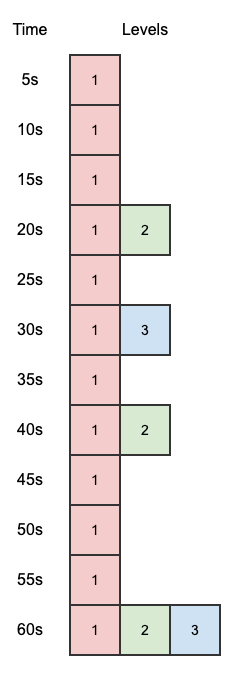Plans
Blip plans specify which metrics to collect and how often.
Plans solve two problems:
- MySQL metrics are unorganized
- Metrics should be collected at different frequencies
The previous part of the introduction addresses the first problem: domains organize MySQL metrics. This part addresses the second problem.
Consider metric Queries (used to calculate QPS) versus a metric to report database size. Queries should be collected every few seconds because QPS a key performance indicator (KPI), so higher resolution (collected more frequently) is better. But database size should be collect every few minutes because it does not change quickly, so lower resolution (collected less frequently) is better. Plans make this possible; here’s a snippet for this example:
kpi: # level name
freq: 1s # collection frequency
collect:
status.global: # domain
metrics:
- Queries # metrics in domain
size:
freq: 5m
collect:
size.database:
# Defaults
The plan snippet above has two levels: kpi and size. A level is defined by a unique collection frequency: 1s and 5m, respectively. Metrics listed for each level are collected at the specified frequency.
When frequencies overlap, Blip automatically collects all metrics in the overlapping levels. This is called leveling up because levels are sorted ascending by frequency and Blip calculates the highest level to collect. For example, suppose a plan specifies three levels:

When these frequencies overlap (measured in seconds), Blip collects each overlapping level:

At 5, 10, and 15 seconds, Blip collects only level 1. At 20 seconds, Blip collects metrics for both levels 1 and 2 because 20 mod 5 = 0 and 20 mod 20 = 0, respectively. At 30 seconds, Blip collects metrics for both levels 1 and 3 because 30 mod 5 = 0 and 30 mod 20 = 0, respectively. And at 60 seconds, Blip collects metrics for all three levels because 60 mod freq = 0. Then the cycle repeats: at time 65 seconds, Blip collects only level 1 again, and so forth.
Each monitor has its own plan—or copy of a shared plan. Although the common use case is a single plan for all monitors, Blip can collect different metrics—at different frequencies—for each monitor.
Blip plans can do more, but for this introduction it’s sufficient to know that they allow you to fine-tune metrics collection, which increases the quality of monitoring while reducing costs.
Last page; keep going: Sinks ↓